Holiday Gifts for the Gardener 2023
Posted on Saturday, December 2, 2023 · Leave a Comment
Once again it is time to find the perfect gifts for your loved ones. Gardeners are easy to shop for because there are so many good things to shop for, and they will be probably be pleased with whatever you choose. As a shopper, I always try to support local, family owned businesses – they support our community and I want to support them when possible. Let’s take a look at some ideas.
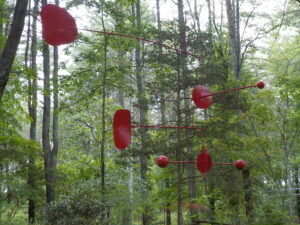
Sculpture in the woods at Bedrock Gardens
Think about buying tickets for you and your gardening friend to a special garden, or perhaps one of the spring flower shows. This will allow the two of you to have some time together and to get some ideas about what you both can do in your gardens. One of my favorite gardens is Bedrock Garden in Lee, NH. This garden was developed by plant guru Jill Nooney and her husband, Bob Munger, over a 25 year period and recently achieved 501-(c)-3 status as a non-profit. Not only does it have a fabulous collection of plants, Jill is a sculptor and welder who has created art that is displayed in the gardens. This is truly a gem of a place and worthy of visits. Suggested donation of $15. See their website for schedules.
Another garden I love is Saint Gaudens National Historic Site in Cornish, NH. Augustus Saint Gaudens was a world-known sculptor who lived and worked there in the early 20th century. The well-maintained formal gardens and grounds are enhanced by his fabuolous life-sized (or larger) bronze sculptures. The grounds are open year-round, and the galleries are open from Memorial Day weeknd through October 31. Admission is $10 and is valid for 7 days.
Of the Spring Flower Shows, the Connecticut show in Hartford is probably the biggest in New England, and well worth a visit. It will be February 22 to 25 in 2024 and although tickets are not yet on sale, you can make up a nice card inviting your gardening buddy to go with you.
Garden tools are generally a hit. On my second birthday I was given a child-sized wheelbarrow, a watering can and a shovel, all of which helped form me as a life-time gardener. Most garden centers sell good quality tools for kids made of metal, not plastic. See what you can find for a small person in your life.

I’ve had this Smart Cart for 20 years
Adults like tools, too. For 20 years now I’ve had a Smart Cart, a well balanced two-wheel cart. The frame is made of airplane-grade tubular aluminum and the 7-cubic ft body of heavy-duty plastic. It comes either with bike-type wheels or smaller, fatter wheels capable of traversing wet areas more easily and carrying heavier loads. I chose the wide wheels, which make the cart rated for 600 pounds. The narrower wheels are rated for 400 lbs. I’ve never had a flat tire and the cart has served me well. The bin pops out if you want to wash a dog in it, or carry home manure in your Subaru. It is not inexpensive, but worth the investment.
My favorite weeder is the CobraHead weeder, a single-tine, curved hook that teases out roots with ease and precision. It has become an extension of my body – I use it for planting, weeding, and more. About $29 and available not only on-line, but from good garden centers and seed companies everywhere.
Although there may be no better mousetrap to invent, amazingly there is a new design to the shovel, one called the Root Slayer. It is all one piece of steel; it has a straight leading edge that comes sharp and stays sharp. The edges are serrated and able to slice though roots like a hot knife through butter. Great for planting in the woods or near trees. I still use my regular shovel or spade for digging in my garden or filling a wheelbarrow with compost. But if I want to plant a tree in a field, it is great for slicing though sod. I use it for dividing big clumps of daylilies and other tough perennials. Available at good garden centers.
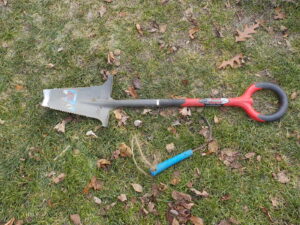
Root Slayer spade and CobraHead weeder are excellent tools
I know most of you probably keep track of garden events on your phone – things like when you planted lettuce seeds or when your delphinium bloom. I don’t. I like an old fashioned journal I can write in with a pen. Blank books are readily available, and some companies even sell special garden journals. Gardening is a slow and thoughtful pastime and lends itself to the handwritten word.
If you know that your gift-recipient starts seeds in the spring, or plans to, you might consider getting an electric heat mat as a gift. They considerably speed up the time needed for germination of weeds in the spring, So for example, corn seeds can take 2 or 3 weeks to germinate in cold, wet soil, but will pop up in 3 to 5 days when on a heat mat. If course, you then have to transplant the seedlings, but that is not bad for a small patch. I generally use a planting flat with 98 cells for corn and transplant them when they have leaves two inches tall.
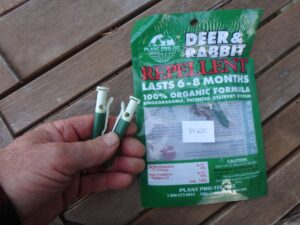
Garlic clips are quite effective deer repellents
If deer are a problem, some garlic-oil clips will add some protection in winter for your tasty trees and shrubs. I’ve had excellent luck with them, specifically with a brand called “Plant Pro-Tec Deer and Rabbit Repellent”. They come in a package of 25 for about a dollar each, and seem to last all winter. The are advertised as working for 6 to 8 months. Of course, depending on how hungry the deer are, the may not be 100% effective.
Seeds are great gifts, and serve well as stocking stuffers. If you save heirloom tomato or flower seeds, you can package up some of your favorites for a friend, along with a good description. And you can gift a nice houseplant, particularly one in bloom. But most of us already have all the houseplants we need.
Lastly, books are great gifts for gardeners – especially now, in winter when we have time on our hands. If I could select just one book, I’d pick “Essential Native Trees and Shrubs for the Eastern United States” by Tony Dove and Ginger Woolridge (2018, Imagine, Bunker Hill Studio Books, $35 hardback). I’m totally behind the movement to plant native plants to support our birds, pollinators and wildlife and this book will answer all your questions – which are attractive to deer, salt tolerant, good for poor soils and much more. It has excellent photos.
Enjoy picking good gardening gifts as you play Santa this year. Your loved ones will love you even more.
Henry is writing just one
gardening article per month
this winter. You may reach him at PO Box 364, Cornish Flat, NH 03746 or by e-mail at
henry.homeyere@comcast.net.
Reflections on 25 Years of Writing a Gardening Column
Posted on Tuesday, November 28, 2023 · Leave a Comment
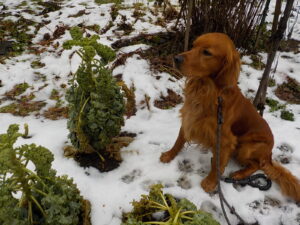
My dogs have always appeared in the column. Here is Rowan who appeared in with kale his first December
On November 8, 1998 my first gardening column appeared in my hometown paper, The Valley News of West Lebanon, NH. Since then I have written over 1,200 weekly columns and answered countless questions from readers. I am 77 years old, and plan to slow down a bit – I’ll be writing just one column per month this winter, and perhaps 2 a month after that. We’ll see.
I’ve learned a lot during that time, interviewed plenty of interesting gardeners, and visited (and written about) great gardens in New England and further afield. Thank you, dear readers for sending me suggestions, asking questions, and generally keeping me on my toes. Early on I wrote about digging in the dirt, and got an irate e-mail from a reader: “It’s not dirt,” she wrote. “It’ soil. It’s what makes a garden work well. Dirt is what you sweep up.” Later, during an election campaign, another reader told me to shut up about politics and write about what I know, gardening. As I said, you have kept me in line all these years.
My favorite interview was with Ray Magliozzi of Public Radio’s Car Talk. He lives in a suburb of Boston and has a simple but elegant garden of rhododendrons, roses, dahlias and a tropical called Datura or Angel’s Trumpet. He has the same quirky sense of humor and boisterous laugh in the garden that he had on the radio. I asked him if there was a common thread between gardening and working on cars. Quickly he answered with a full belly laugh: “Dirt. But garden dirt washes off more easily. The reason I love gardening is that I love getting my hands dirty. When we fix cars, it’s not all science. There’s an art to it, too.
Who else? The White House Gardener, Dale Haney. Tasha Tudor, the reclusive artist and gardener living in southern Vermont. Jean and Weston Cate, octogenarians who introduced me to the Seed Savers Exchange and the Boston Marrow Squash, a winter squash that they told me was the most popular squash grown in America in the 1850’s – and still grown by them. And I interviewed and became friends with Sydney Eddison, a fabulous garden writer who, when I called her recently had just come in from re-building a stone wall – even though she is now in her 90’s.. Gardeners do seem to last a long time.
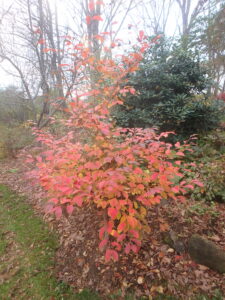
I bought this Stewartia for its blossoms and only learned later that its fall foliage is worth writing about
I love the letters and e-mails of you readers and wish I had saved them all. Here’s part of one that I got recently that might interest you: what to do about the dreaded Asian jumping worm? : “I sprinkled the tea seed meal (using my hand fertilizer spreader) and within a week (after a light rainfall which surely helped the process) the worms came to the surface (ick) and died. It would be lovely if they just stayed in the ground, but it was also gratifying to see that the tea seed meal actually worked! I have been told that they lay eggs this time of year so I will begin the process anew next spring.” She told me that she bought it at her local feed-and-grain store. My reader used 50 pounds for her lawn and gardens – about half an acre. The worms die in winter, and hatch in early summer, so I may try it as soon as I see them next summer. That said, I must warn you that even though this is a natural, organic product, it can have negative effects on fish and amphibians. Do your research, and I will, too. To be continued …
What else have I learned as part of my experience writing a column? Although I had been a gardener since I was a toddler and learned how to grow veggies and flowers from my Grampy, I took took classes to fill in the gaps in my knowledge. I went to Vermont Technical College in Randolph, Vermont and took classes including a great one about all the trees and shrubs that do well in our climatic zone. I already knew all the native trees that grow in Connecticut (where I grew up), but few shrubs and virtually no unusual decorative trees.
I took the Master Gardener course in New Hampshire, and that taught me lots of technical details about things like lawn care, insects and diseases, and lots more that I had never focused on. I drove 60 miles each way for 10 weeks to Concord, NH where I spent half a day taking classes. And I committed to helping teach others in my community – which I have been doing ever since. And it helped expand my knowledge for the column. I continue to take seminars given by experts whenever I can.
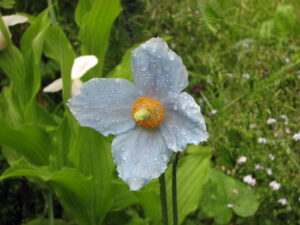
Himalayan Blue poppy is a rare color in the garden. that of the sky.
Writing a column also gave me a great excuse to buy plants. I needed to know, for example, if Toadlily or Himalayan blue poppy would do well here, and what they needed to succeed. I learned to buy perennials in groups of 3 or 5 – to make a bold statement, or to try in various locations.
I needed to learn how to design a beautiful landscape with flowers, trees and shrubs. All that was part of my education. I now grow about 200 kinds of flowers, and nearly 100 kinds of trees and shrubs. I’ve written about the ones that thrived – and the ones I’ve killed.
Eventually I learned not to buy plants unless I already have a place in mind where I might plant them. Okay, I fib a little there. I am a sucker for beautiful flowers in bloom, and will buy them – and make a place for them somewhere!
What is my advice to you after all these years? Never get discouraged or give up. But also don’t bite off too much work. Start small and increase your gardens, one bed at a time. Stay true to using organic practices: chemicals disrupt the natural balance of nature. Make a long term plan for your garden if you can. Establish sight lines, pathways, and create small “rooms” in the garden. Plant trees early on – they take the longest to reach maturity. And when you reach my age, those trees can be magnificent. I planted several in 1972 that please me every I think about them. Lastly, take time to sit down and enjoy your garden. You deserve to do so every day of the year.
I’d love tor hear from you, dear reader. Is there an
article that you remember best, or one you clipped and still refer to? I’m at
henry.homeyer@comcast.net or PO Box 364, Cornish Flat, NH 03746. Thanks!
Late Fall Chores in the Garden
Posted on Tuesday, October 31, 2023 · Leave a Comment
For many of us, November is a drab and dreary month: days are short, gray skies the norm. Flowers are largely gone, the soil is soggy and a drizzle or a downpour is common. Soon snow will not be unusual- we’ve already seen a wintry mix. But there are things you can do when the sun comes out – or with rain gear on.
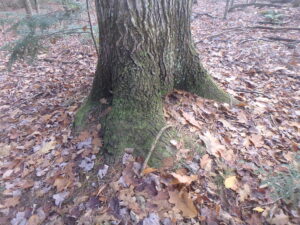
Trunk flare is easy to see on big trees but harder on new plantings
If you planted trees in the past few years, you should look at them carefully. Most planting tags on purchased trees tell you to plant them at the depth they are in the pot. Unfortunately, many trees are grown on huge farms and slapped into pots without regard to the “trunk flare” – that part of the tree that should be above ground.
Look at a mature tree planted by mother nature – or a squirrel. You will see that the base of the tree widens out, and often roots are seen snaking across the soil near the tree for a while before diving down to seek nutrients and moisture. When planting a tree it is essential that the trunk flare be above ground. If not, soil fungi will rot the bark and eventually kill the cambium layer below it. This will kill the tree in six to ten years. Even if the bark looks flaky and damaged, it probably will recover if you take action now.
If the tree you planted comes straight out of the ground like a telephone pole, or if there is mulch piled up against the tree, you must remove the material that will cause problems.
Mulch is easy to fix – take your hand and pull it back, creating a doughnut hole for the trunk, at least 4-inches all around. Mulch has its place: it will keep down weeds and help prevent the soil from drying out in times of drought. But more than 4 inches of mulch can also prevent light rains from reaching the roots. Don’t overdo it. No mulch volcanoes. I’ve been seen removing mulch from trees in public spaces!
If there is soil over the trunk flare, use a hand tool to loosen the soil and pull it back, too. You may find little roots there, but cut them off. Re-grade the area for a foot or more around the tree in ll directions. For a larger tree that was sold in a burlap wrapping, it is not uncommon to find 3 to 6 inches of soil over the trunk flare. The burlap wrapping – now often made of plastic materials – should have been removed at planting time. If not, your tree is doomed. Plastic wrapping will never degrade, so need to dig up the tree and remove it now. Burlap will degrade in time, but often not for years.
What else is there to do in the garden now? This is a good time to move shrubs or small trees that are not doing well where they are. Roots do most of their growth between the time leaves drop and the ground freezes, ,which makes this a good time for moving them. Cool temperatures and rainy days help plants you move now, too. sd

Mulch around a tree will hold in water and help keep weeds from stealing water.
I was visiting long-time friends in Ohio recently, and they had 3 Fothergilla shrubs that had been in the ground 5 years and done almost nothing. I took a garden fork, thrust it into the soil nearby and tipped it back. Out popped the root ball – as if it had been planted the day before. I picked it up and took a look. Clearly the shrub had been in a one-gallon pot for a long time before they planted it. The roots had grown around and around the pot, keeping them from extending out into neighboring soil for moisture and minerals.
After soaking the root ball in a pail of water, I used my fingers, a small folding saw and a CobraHead weeder to tease the roots apart. I broke or cut some, but it didn’t matter. The shrubs were doomed unless I could get the roots pointed out and away from the tangled mess they’d been in. I replanted them in places with more sunshine and less competition from big perennials in beds where they should grow and be happy. It may take a year or two before they really start to thrive.
It’s tough to know just where to plant a tree or shrub for optimal growth. I like to observe the same species in another garden or ask a friend if they’ve had luck with the same species. The internet can help if you consult a university or arboretum website. I like books, too, especially any written by Michael Dirr. He seems to know more than anyone else. So do your homework, and think about moving any unhappy woody plants.
By the way, it’s not too late to plant spring bulbs, garlic or bulbs for forcing in pots. I particularly like forcing spring bulbs (daffodils, tulips, crocus and more) by potting them up now and keeping them in a cold place where they won’t freeze. Then in February and March I bring them into the warmth of the house, and they bloom early. I pot up enough to give some away to ailing or aged friends.
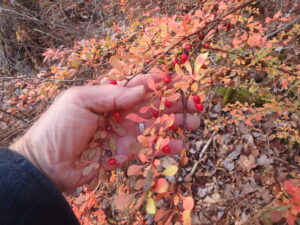
Barberry is easily identified by its red berries now
This is a good time to dig out invasive shrubs like burning bush or barberry that have been planted by birds. Their distinctive leaf color will help you find them now in your woods.
On the next to last day of October this year I plugged in my blue “fairy lights” in my Merrill magnolia and a nice pear tree. It was a gloomy, wet day, and the blue lights looked great against the yellow leaves. Some people call these Christmas or holiday lights, but I consider them just a cheerful boost to my spirits when gardening is nearly done and weather keeps me from doing my final chores.
Henry is UNH Master
Gardener, a regular speaker at
garden clubs and libraries, and the author of 4
gardening books. Reach him by e-mail at henry.homeyer@comcast.net.
Tips for Growing Great Garlic
Posted on Tuesday, October 10, 2023 · Leave a Comment
If you lean toward lazy (or have kids, dogs and a job), growing garlic may be just the ticket. It is the easiest of all vegetables to grow. Once planted and mulched, it requires little or no work until harvest. A good harvest is guaranteed if follow my instructions. Even with all the strange weather we’ve seen, I’ve never had a bad crop in the past 25 years or so of growing garlic.
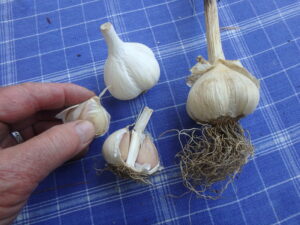
Hard neck garlic cloves surround a stiff neck and are best for New England gardens
Now is the time to buy garlic for planting – unless you have some from your own garden saved for that purpose, as I do. You’ll want to get your garlic planted a month before the ground freezes, so depending on where you live, you may want to plant some soon. Garlic needs to establish roots now, and is not generally planted in the spring.
There are two categories of garlic: hard neck and soft neck. Both will grow in New England, but hard neck is the type grown by most farmers, and the most cold-hardy. It produces a stiff scape or stem each summer that is edible. Soft neck garden generally comes from California, and is good in the kitchen; it is also the type braided and hung from the ceiling in Italian restaurants as decoration. Hard neck garlic generally has more flavor; a wide variety of flavors is possible, depending on the type you grow.
Garlic does best in rich soil that drains well. If you have a heavy clay soil (one that is sticky when wet), you will need to add plenty of compost to your soil. Adding sand will not help, as sand added to heavy clay produces something like concrete that hardens up in dry times.
If you have poor soil, you may want to build a wood-sided raised bed, and add plenty of compost and topsoil that you purchase in bulk or in bags. I find Moo-Doo brand composted cow manure and topsoil are a good soil additives that are sold in bags in many garden centers. A 50-50 mix of your soil (or purchased topsoil) and compost should work well.
When making a wood-sided bed, I don’t recommend treated lumber. Even though most treated lumber is safe to handle and much less toxic than 20 years ago, I don’t want any chemicals leaching into my soil. I use rough-sawn lumber from a local sawmill, preferably hemlock. It generally lasts about 10 years. Eight-inch wide planks are wide enough to make a nice box.
Plain pine boards will work, too, and metal corners are readily available at garden centers or from catalogs like Gardeners Supply and Lee Valley Tools. The corners make constructing a garden box easy even for non-carpenters. All you need is a cordless drill to drive the screws. Carrots and other root crops do well in garden boxes, so you can alternate them with garlic in subsequent years if you build 2 or more boxes.
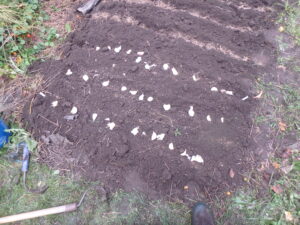
Place your garlic cloves on the soil to establish spacing before planting
I generally use my own garlic for planting, as it has adapted to my soil and climate over the years. But if I see big, fat bulbs of garlic at a farmers market, I sometimes buy some. I don’t recommend buying garlic for planting at the grocery store as most has been treated to prevent it from germinating, and so it will last longer.
Where can you get garlic for planting? If there is none at your local farmers market, you can get organic garlic from Johnny’s Selected Seeds in Maine (877-564-6697 or
www.johnnyseeds.com). But don’t wait too long – they sell out most years.
Once the soil is loose and weed-free, I plant. I take a CobraHead weeder, a nice single-tined weeder, and make furrows in the soil of my raised bed. I keep the furrows about 8 inches apart. I sprinkle some organic bagged fertilizer into each row, and stir it in.
I break the garlic bulbs apart, separating the cloves – there are usually 5 to 10 cloves per head. I push the cloves into the loose soil, pointy end up, about 3 inches deep, and 4 inches apart. I cover with soil, and then pat it gently.
The last step is key if you want a weed-free garlic bed: put a foot of fluffy mulch hay or straw over the planted garlic. The straw will pack down over the winter and make a nice mulch that will keep most weeds from growing, but the garlic will push through it. It will be ready to harvest next July.
D
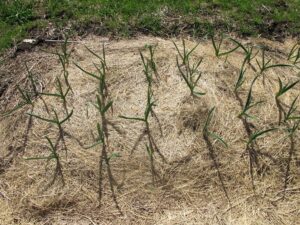
Garlic grows through th mulch, shown here in May
epending on when you plant, the soil temperature, and when real cold weather comes, your garlic may send up a few green shoots this fall. Don’t panic! It won’t hurt your garlic. When cold weather comes, it will go dormant and do just fine next spring.
I believe that garlic is a healthy and tasty addition to my diet. It may even be medicinal – it has been used that way for centuries. Some believe that if you crush your garlic and then wait 10 minutes before cooking, it will generate cancer-fighting compounds. Who knows? Certainly it can’t hurt.
And this winter if you chew on a clove of garlic before going to the store, you’ll never get a cold – because people will stand back from you in line!
Henry lives in Cornish Flat, NH. He is the author of 4
gardening books and is a UNH Master
Gardener. His e-mail is
henry.homeyer@comcast.net.
Putting the Garden to Bed
Posted on Tuesday, October 3, 2023 · Leave a Comment
To me, this felt like the summer that never was. It was rarely hot and sunny. The rainy gray days felt more like those in Portland, Oregon than in New England. Even so, the summer we had is largely over and it’s time to clean it up and get ready for winter. Let’s take a look at what we need to do.
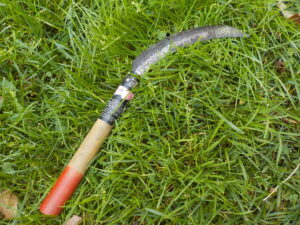
This harvest sickle is great for cutting back stems of flowers
It’s time to start cutting back flowers that are no longer blooming. I like using a small serrated “harvest sickle” for the job instead of hand pruners. It’s available from www.OESCOinc.com for about $8. I grab a handful of stems and slice through them with the tool, getting several stems at once. Of course you could use an old steak knife instead. I leave stems bearing seed heads that the finches, cardinals and other seed-eaters might munch on this winter. Wear gloves when you use the tool – it is very sharp!
I am conscious of erosion when removing plants in the fall. I think it’s better to cut off the stems of big zinnias, for example, than yank them now. That way I am not opening up the soil, making it vulnerable to erosion or providing a nice resting spot for air-borne weed seeds. Many weed seeds are tiny and can blow in from your next-door neighbor’s garden. I can always dig out roots in the spring when I plant something else, and they may decay and add some organic matter to the soil in the meantime.
Once you have cut back and cleaned up the garden a bit, you should pull all the weeds. I know this can be a tedious chore, it’s better done now than in the spring. Weeds in spring will start growing long before you start planting – and before the soil is dry enough for you to work it.
Weeding is easiest to do when the soil is moist. If you have big, deep-rooted weeds like burdock, you should use a garden fork to loosen the soil. Plunge the fork into the soil and tip it back, loosening the soil. Do that in a few places for a big weed. Then pull s-l-o-w-l-y. A quick yank will break off roots that will survive and grow next summer. Any weed that is loaded with seeds should go in a separate compost pile -otherwise the seeds could come back to haunt you, even years later. For smaller weeds, I like my CobraHead weeder.
And here’s a little mentioned fall task: getting rid of the flowers that have not done well in the past few years. That’s right, not everybody gets to ride the bus. This is a good time to say to plants that have not performed, “You’re off the bus. Go live in the compost pile.” A plant that is too aggressive – or one that just won’t bloom – should be exiled. Next spring, that gives you license to buy something nice – you have a gap to fill in the perennial border.
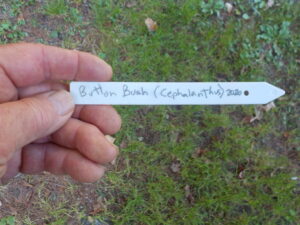
Plastic tags are good reminderrs of plant names
What else? Place labels in the back right corner of any clump of flowers that is relatively new. By spring you may have forgotten what it is. I like those narrow white plastic labels. Not to look at, but to do a job. I use a #2 pencil or a special crayon to write the name, and then I push the label deep into the soil so that only a smidge is showing. If I can’t come up with a name, I know where to look. Back right corner.
Outdoor flower pots need to be emptied, cleaned and put away after frost. Don’t wait until December to do this – if a pot full of wet soil freezes, it will crack. You may as well clean out the pots now – rather than in the spring. And save all that potting soil. You can invigorate it in the spring by adding compost and some organic fertilizer. So fill up a trash can or a few buckets with that potting soil and re-use it.
The vegetable garden needs to be weeded, and preferably mulched with chopped up fall leaves. If, like me, you make mounded wide beds, re-shape the beds now by hoeing up some soil from the walkways. Pull dead plants and get rid of them.
If you have an asparagus patch, look to see if your plants are loaded with those little red “berries”, their seeds. If you see seeds, cut down the stems right now. Some of those seeds will settle in and start more asparagus plants – and they will fight for moisture and minerals just as weeds do.
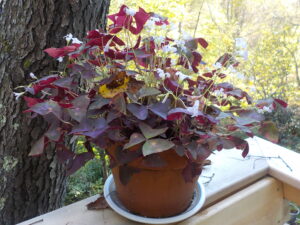
Empty out flower pots before they freeze and burst – or bring the plants inside for the winter
If you have old maple trees, think about giving them some ground limestone or agricultural lime this fall. Acid rain dissolves and washes away the calcium they need. Adding some lime will increase the vigor of your trees. And remember that soil compaction is bad for tree roots. Don’t park your car near a tree you love. Sprinkling a little compost over the soil will loosen it up as earthworms move it down and microorganisms break it down. Roots go far from the trunk of trees – much farther than the “dripline” of the branches.
My last task is always to rake the leaves. I chop mine in a chipper-shredder, but you can also run over them with a lawnmower. Leaves are full of good nutrients for plants, and are much loved by night crawlers and microorganisms. Rake the leaves onto a tarp and drag them away – that’s much more efficient than packing them into a wheelbarrow. Once it has rained, the leaves will settle in and make your plants feel cozy and loved.
Reach Henry at PO Box 364, Cornish Flat, NH 03746 or by email at
henry.homeyer@comcast.net. He is the author of 4
gardening books.


















